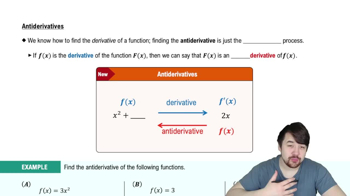Evaluate the following integral:
Table of contents
- 0. Functions7h 54m
- Introduction to Functions16m
- Piecewise Functions10m
- Properties of Functions9m
- Common Functions1h 8m
- Transformations5m
- Combining Functions27m
- Exponent rules32m
- Exponential Functions28m
- Logarithmic Functions24m
- Properties of Logarithms36m
- Exponential & Logarithmic Equations35m
- Introduction to Trigonometric Functions38m
- Graphs of Trigonometric Functions44m
- Trigonometric Identities47m
- Inverse Trigonometric Functions48m
- 1. Limits and Continuity2h 2m
- 2. Intro to Derivatives1h 33m
- 3. Techniques of Differentiation3h 18m
- 4. Applications of Derivatives2h 38m
- 5. Graphical Applications of Derivatives6h 2m
- 6. Derivatives of Inverse, Exponential, & Logarithmic Functions2h 37m
- 7. Antiderivatives & Indefinite Integrals1h 26m
- 8. Definite Integrals4h 44m
- 9. Graphical Applications of Integrals2h 27m
- 10. Physics Applications of Integrals 3h 16m
- 11. Integrals of Inverse, Exponential, & Logarithmic Functions2h 34m
- 12. Techniques of Integration7h 41m
- 13. Intro to Differential Equations2h 55m
- 14. Sequences & Series5h 36m
- 15. Power Series2h 19m
- 16. Parametric Equations & Polar Coordinates7h 58m
8. Definite Integrals
Fundamental Theorem of Calculus
Problem 5.3.35
Textbook Question
Definite integrals Evaluate the following integrals using the Fundamental Theorem of Calculus
∫₁⁹ 2/(√𝓍) d𝓍
 Verified step by step guidance
Verified step by step guidance1
Step 1: Recognize that the integral ∫₁⁹ 2/(√𝓍) d𝓍 can be rewritten using exponents. Recall that √𝓍 is equivalent to 𝓍^(1/2), so the integrand becomes 2 * 𝓍^(-1/2).
Step 2: Apply the power rule for integration. The general formula for integrating 𝓍^n is ∫𝓍^n d𝓍 = (𝓍^(n+1))/(n+1) + C, where n ≠ -1. Here, n = -1/2.
Step 3: Compute the antiderivative of 2 * 𝓍^(-1/2). Using the power rule, the antiderivative becomes 2 * (𝓍^(1/2))/(1/2), which simplifies to 4 * 𝓍^(1/2).
Step 4: Use the Fundamental Theorem of Calculus to evaluate the definite integral. Substitute the limits of integration (𝓍 = 1 and 𝓍 = 9) into the antiderivative. This gives [4 * √𝓍] evaluated from 1 to 9.
Step 5: Calculate the difference between the values of the antiderivative at the upper and lower limits. Specifically, compute 4 * √9 - 4 * √1. Simplify the expression to find the final result.
 Verified video answer for a similar problem:
Verified video answer for a similar problem:This video solution was recommended by our tutors as helpful for the problem above
Video duration:
2mPlay a video:
Was this helpful?
Key Concepts
Here are the essential concepts you must grasp in order to answer the question correctly.
Definite Integrals
Definite integrals represent the signed area under a curve between two specified limits. They are calculated using the integral symbol with lower and upper bounds, indicating the interval over which the function is evaluated. The result of a definite integral is a numerical value that quantifies this area, which can be interpreted in various contexts, such as physics or economics.
Recommended video:

Definition of the Definite Integral
Fundamental Theorem of Calculus
The Fundamental Theorem of Calculus links the concept of differentiation with integration, providing a method to evaluate definite integrals. It states that if a function is continuous on an interval, then the integral of its derivative over that interval equals the difference in the values of the original function at the endpoints. This theorem allows for the computation of definite integrals by finding an antiderivative of the integrand.
Recommended video:

Fundamental Theorem of Calculus Part 1
Antiderivatives
An antiderivative of a function is another function whose derivative yields the original function. In the context of definite integrals, finding an antiderivative is crucial because it allows us to apply the Fundamental Theorem of Calculus. For example, if we need to evaluate the integral of a function, we first determine its antiderivative and then compute the difference between its values at the upper and lower limits of integration.
Recommended video:

Antiderivatives

 6:11m
6:11mWatch next
Master Fundamental Theorem of Calculus Part 1 with a bite sized video explanation from Patrick
Start learningRelated Videos
Related Practice
Multiple Choice
124
views
